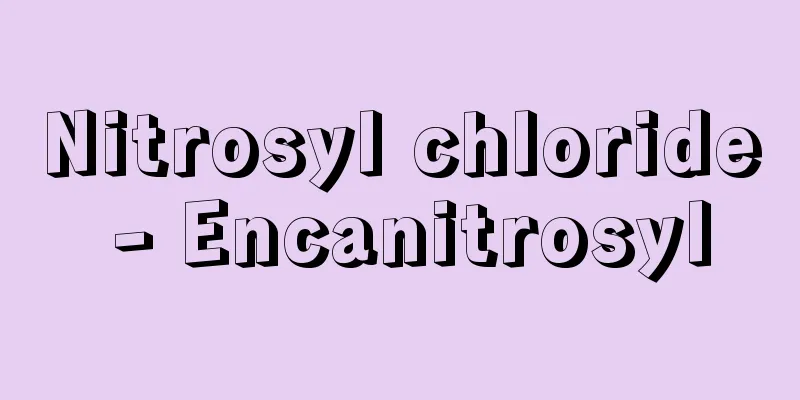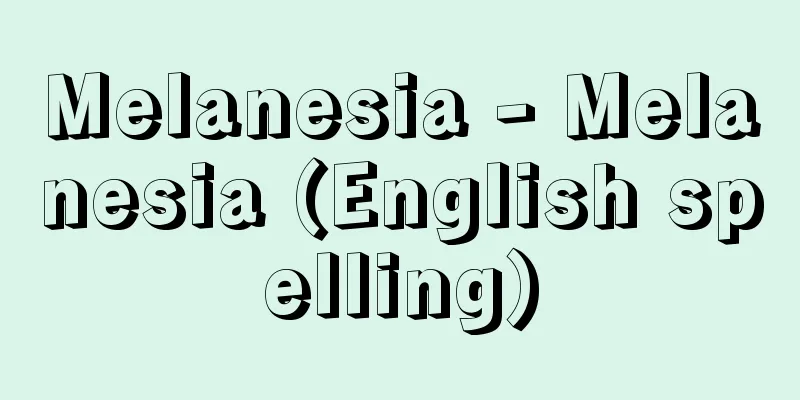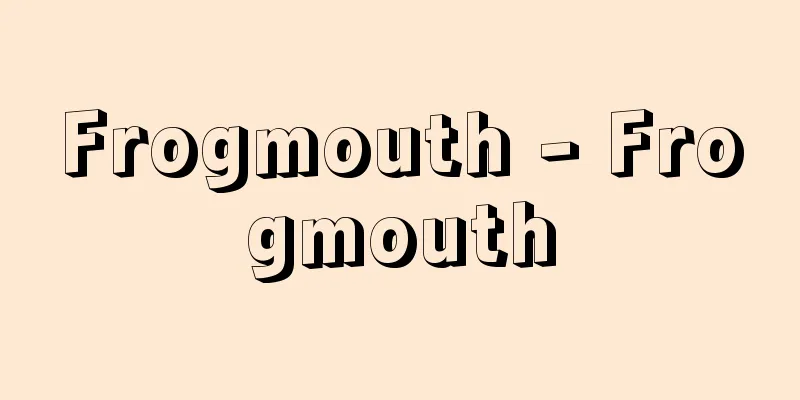Natural enemy - Tenteki

|
An organism that attacks another organism and either kills it or reduces its reproductive ability, generally referring to beneficial organisms that reduce the population of harmful organisms such as pests and weeds. There are the following types of natural enemies: [Kei Morimoto] Natural enemies of harmful animals(1) Parasitic natural enemies These spend a certain period of their lives inside the body of a harmful host animal, either killing it or reducing the number of eggs laid. They are called predatory parasites, in distinction from true parasites such as fleas and ticks, which do not affect the lifespan or reproductive capacity of the host. These include parasitic wasps (ichneumons, braconid wasps, small wasps, gall wasps, ground wasps, etc.), parasitic flies (tachinid flies, head flies, etc.), and parasitic nematodes, and many of them grow by feeding on a single host, with each species having a specific host. (2) Predatory natural enemies: These hunt for food on their own and eat one or more harmful animals in their lifetime. Ladybugs, fly-flies, and lacewings prey on aphids and scale insects. Ground beetles, ants, praying mantises, and spiders feed on many insects. Lizards, frogs, and birds are also predatory natural enemies. (3) Pathogenic microorganisms: Viruses, bacteria, fungi, nematodes, etc. that cause infectious diseases. Examples include the polyhedroblast disease of gypsy moth, pine moth, and fall webworm, Bacillus thuringiensis, a type of spore-forming bacterium that produces crystalline toxins, and Bacillus subtilis, which is used to control scarab beetle larvae. [Kei Morimoto] Weeds’ natural enemy(1) Herbivore Animals: Animals that feed on weeds, such as leaf beetles, weevils, grass carp, and shrimp. (2) Pathogens: These cause disease in weeds and have been reported to be a type of rust fungus. [Kei Morimoto] Pest control using natural enemiesThis is generally called biological control, but because control using pathogenic microorganisms is a different method, it is called microbial control. The methods are broadly divided into three categories. (1) Permanent use of natural enemies This involves introducing natural enemies from the native habitat of invasive pests, or from outside the native habitat, including indigenous pests, with the aim of having the introduced natural enemies be permanently effective, and was the basic method of biological control until around 1940. There are many examples, such as the Bedaria ladybug, which preys on the Iseriha scale insect, Aphididae, which parasitizes the ruby wax scale insect, and Totrichum longifolia, which parasitizes the chestnut gall wasp. (2) Temporary establishment method: There are two methods: the inoculation release method, in which natural enemies are released at the early stage of pest emergence when the density of natural enemies is low, or natural enemies that cannot survive winter are released in the spring, and the biological pesticide method, in which artificially bred natural enemies are released in large quantities. An example of the former is the pine needle parasitic wasp, which parasitizes the pine needle gall midge, and an example of the latter is the parasitic wasp of the greenhouse whitefly and the mulberry mealybug. (3) Environmental Improvement Methods These methods aim to make natural enemies more effective by manipulating the environment. These include preserving natural enemies by interplanting plants that harm alternative hosts or by row-cutting, introducing nectar-producing plants that increase the activity of parasitic wasps, and eradicating ants that hinder the activity of natural enemies. These methods may also include the use of pesticides that have little effect on natural enemies and integrated pest control, such as genetically manipulating pests. Examples include increasing the parasitism rate of Japanese bush wasps on scarab beetle larvae by introducing parsley, carrots, and wild umbelliferous plants as nectar-producing plants, preserving phytoseiid mites, a natural enemy of spider mites that also eat the pollen, by planting legumes in citrus orchards, and preserving natural enemies by successively sowing strips of grass and harvesting them. Orchards also employ measures to preserve the scale insect parasitoids and predators by spraying alternate rows with insecticides and using surrounding hedges that provide alternative hosts. [Kei Morimoto] Microbial controlPathogenic microorganisms are strongly influenced by environmental factors such as temperature and humidity, but since many of them can be mass-produced, they are mainly used as biological pesticides, and are also used in forests to suppress short-term epidemics. In Japan, since sericulture areas are widespread, the first condition for these pathogenic natural enemies is that they do not affect silkworms, and so viral diseases with a limited host range, filamentous fungi with a narrow range of infection, and strains of Bacillus thuringiensis that produce species-specific toxins are used. Since it takes some time for these to become effective after spraying, they cannot be used like fast-acting insecticides in intensive agricultural systems, but they are effectively used on trees with a relatively high tolerance for damage and on pastures where spraying with insecticides is not possible. Polyhedroviruses have been sprayed aerialally against the larvae of pine moths, red-spotted snails, and gypsy moths, and have been successfully used in trials to control many pests. [Kei Morimoto] Biological control of weedsSince the successful control of prickly pear cactus, which had invaded Australia, and the successful control of St. John's wort beetle, which had spread to California pastures, by introducing cactus moths from their native habitats, the introduction of herbivorous insects from their native habitats to naturalized plants has begun in earnest, but the use of native insects to control native plants that have become pests in artificial environments is also being considered. In Japan, the release of native small leaf beetles on Rumex obtusifolius, which had spread due to grassland development, was successful in controlling it, and it has been confirmed that stag beetles are effective in controlling weeds in rice paddies. [Kei Morimoto] "Natural Enemies: Approaches to Biological Control" by Kyozo Yasumatsu (1970, NHK Publishing)" ▽ "Comprehensive Control" edited by Shoji Fukaya and Keiji Kiritani (1973, Kodansha)" ▽ "Recent Advances in Insect Science" edited by Shojiro Ishii (1981, University of Tokyo Press)" ▽ "Natural Enemies of Pest Insects" by Yozo Murakami (1982, New Science Publishing)" ▽ "New Applied Entomology" by Yoshihiro Hirashima et al. (1986, Asakura Publishing) [Reference] |Source: Shogakukan Encyclopedia Nipponica About Encyclopedia Nipponica Information | Legend |
|
ある生物を攻撃して殺すか繁殖能力を低下させる他種の生物で、一般には害虫や雑草など有害生物の個体数を低下させる有益生物をいう。天敵には次の種類がある。 [森本 桂] 有害動物の天敵(1)寄生性天敵 生活の、ある時期を寄主である有害動物の体内で過ごしてこれを殺すか、または産卵数を減少させるもので、ノミやダニのように寄主の寿命や繁殖力に影響を与えない真の寄生虫と区別して、捕食寄生虫とよばれる。これには寄生バチ(ヒメバチ、コマユバチ、コバチ、タマバチ、ツチバチなど)、寄生バエ(ヤドリバエ、アタマアブなど)、寄生線虫などがあり、一頭の寄主を食べて育ち、種類ごとに寄主が決まっているものが多い。 (2)捕食性天敵 これは自分自身で餌(えさ)を探し、一生の間に一頭以上の有害動物を食べるもので、テントウムシ、ヒラタアブ、クサカゲロウなどがアブラムシやカイガラムシを捕食し、オサムシ、アリ、カマキリ、クモなどは多くの昆虫を餌とし、トカゲ、カエル、鳥なども捕食性天敵である。 (3)病原微生物 伝染性の病気をおこさせるウイルス、細菌、糸状菌、線虫などで、マイマイガ、マツカレハ、アメリカシロヒトリなどの多角体病、結晶性毒素を産出する芽胞細菌(がほうさいきん)の一種Bacillus thuringiensis、コガネムシ幼虫の防除に利用される黄(おう)きょう菌などがある。 [森本 桂] 雑草の天敵(1)食植動物 雑草を食物とする動物で、ハムシ、ゾウムシ、ソウギョ、カブトエビなどである。 (2)病原菌 雑草に病気をおこさせるもので、さび病菌の一種で報告がある。 [森本 桂] 天敵による有害生物防除これは一般に生物的防除とよばれるが、病原微生物による防除は方法が異なることから微生物的防除といわれる。その方法は三つに大別される。 (1)永続的天敵利用法 侵入害虫に対してその原産地から、また土着害虫も含めて原産地以外から天敵を導入するもので、導入天敵が永続的に有効に働くことを目的とし、1940年ごろまでは生物的防除の基本的な方法であった。イセリヤカイガラムシを捕食するベダリヤテントウ、ルビーロウカイガラムシに寄生するルビーアカヤドリコバチ、クリタマバチに寄生するチュウゴクオナガコバチなど多くの例がある。 (2)一時的定着法 天敵密度の低い害虫発生初期にこれを放飼したり、越冬できない天敵を春になって放す接種的放飼法と、人工増殖した天敵を大量に放す生物農薬的な利用法がある。前者の例としてマツバノタマバエに寄生するマツタマヤドリハラビロコバチ、後者の例としてオンシツコナジラミやクワコナカイガラムシの寄生バチがある。 (3)環境改良法 環境に人手を加えることによって天敵が有効に働くことを目的とするもので、代替寄主の加害する植物の混植や条(すじ)刈りなどによる天敵の温存、寄生バチの活動を高める蜜源(みつげん)植物の導入、天敵の活動を妨害するアリの駆除などの方法がある。これにはさらに、天敵に影響の少ない農薬の使用や、害虫を遺伝的に操作するような総合防除までも包含させることがある。その実例として、パセリ、ニンジン、野生のセリ科植物などを蜜源植物として導入することでコガネムシ幼虫に対するコツチバチの寄生率を高めたり、ミカン園にマメ科植物を植えることでその花粉も食べるハダニの天敵カブリダニを温存することや、牧草を帯状に順次播種(はしゅ)して収穫することで天敵を残す方法がある。また、果樹園では一列おきに殺虫剤を散布したり、周囲の生け垣に代替寄主のつく樹木を用いることで、カイガラムシの寄生バチや捕食虫を温存する方法が行われている。 [森本 桂] 微生物的防除病原微生物は温度や湿度など環境の影響を強く受けるが、大量生産の可能なものが多いことから生物農薬的な利用が主となり、林地では短期間の流行を目的とした使用も行われている。日本では養蚕地域が広いことから、これら病原天敵はカイコに影響がないことが第一条件とされ、寄主範囲の限られたウイルス病、伝染範囲の狭い糸状菌、種特異的な毒素をつくるBacillus thuringiensisの系統が利用されている。これらは散布から有効に働くまでにある時間が必要であることから、集約的な農業体系のなかでは速効のある殺虫剤のようには利用できないが、被害許容水準の比較的高い樹木や殺虫剤散布のできない牧草地などでは効果的に利用され、マツカレハ、ハラアカマイマイ、マイマイガなどの幼虫に対して多角体ウイルスの空中散布が行われており、試験的には多くの害虫防除に成功している。 [森本 桂] 雑草の生物的防除オーストラリアへ侵入したウチワサボテンにサボテンガを、またカリフォルニアの牧草地に広がったコゴメオトギリソウにオトギリソウハムシをそれぞれの原産地から導入して防除に成功して以来、帰化植物に対して原産地から食植昆虫の導入が本格的に研究され始めたが、人為環境下で害草化した土着植物に対する土着昆虫の利用も考えられている。日本では草地の造成で拡大したエゾノギシギシに土着のコガタルリハムシを放飼して制圧に成功し、また水田の雑草防除にカブトエビが有効なことが確かめられている。 [森本 桂] 『安松京三著『天敵 生物制御へのアプローチ』(1970・日本放送出版協会)』▽『深谷昌次・桐谷圭治編『総合防除』(1973・講談社)』▽『石井象二郎編『昆虫学最近の進歩』(1981・東京大学出版会)』▽『村上陽三著『害虫の天敵』(1982・ニュー・サイエンス社)』▽『平嶋義宏他著『新応用昆虫学』(1986・朝倉書店)』 [参照項目] |出典 小学館 日本大百科全書(ニッポニカ)日本大百科全書(ニッポニカ)について 情報 | 凡例 |
<<: Spot analysis - Tenteikibunseki (English spelling)
Recommend
Natural unemployment rate
The unemployment rate that exists in a long-term e...
Coronary circulation
...Clinically, this leads to the development of a...
Hexadecanol
...A typical naturally occurring chain saturated ...
Heaven - Otensho
…It is also called Daitenjo-dake. It means the hi...
amané (English spelling) amane
...There are many other forms of traditional folk...
Gill, Sir David
Born: 12 June 1843, Aberdeen [Died] January 24, 19...
Shirakami Mountains
This mountainous area, which was registered as a W...
chapati
...General term for bread made in North India. In...
Alkali Factory Method - Alkali Factory Information
...However, because it was complicated with exist...
Santanka (Santanka) - Santanka
Also known as Ixora. An evergreen shrub of the Rub...
Sargassum thunbergii (English spelling) Sargassumthunbergii
…[Mitsuo Chihara]. . . *Some of the terminology t...
Bouvardia ternifolia (English spelling) Bouvardia ternifolia
…[Ichiro Sakanashi]. … *Some of the terminology t...
Ichimura Uzaemon (9th generation)
Born: 1724 [Died] Tenmei 5 (1785) He was the head ...
"The Chinese in the Sea"
...It is said that Jia Dan always met with foreig...
Hedgehog (Japanese: hedgehog)
A general term for mammals belonging to the insect...









